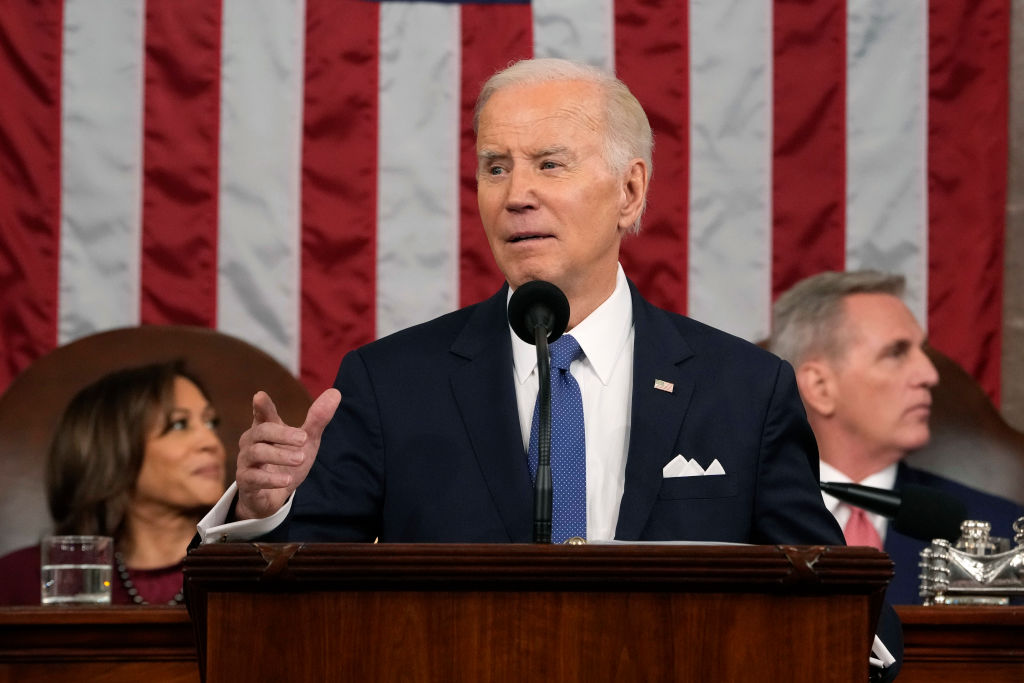President Biden delivered his State of the Union address on Tuesday, touching on topics from inflation and the deficit to Ukraine and entitlement spending. An estimated 27.3 million people watched the speech on television, a 29 percent decline from Biden’s first State of the Union.
Several of his comments throughout the speech were inaccurate or lacking context.
The claim: “I stand here tonight after we have created, with the help of many people in this room, 12 million new jobs—more jobs created in two years than any president has created in four years, because of you all, because of the American people.”
The facts: This claim is missing important context. It is true that 12.1 million jobs were added to the American economy between January of 2021 and January of 2023. In terms of raw numbers, this does indeed constitute “more jobs created in two years than any president has created in four years.”
However, it’s important to note that Biden benefited from an economic recovery that began during the Trump presidency—after the job losses that resulted from the pandemic bottomed out and began to climb upward again. According to the Bureau of Labor statistics, this happened in April 2020, when there were 21.9 million fewer jobs in April 2020 than there had been in February 2020. The rise in employment since that time carried over from the Trump administration to the Biden administration. In fact, the economy added 12.5 million jobs in just the final nine months ofTrump’s presidency.
It’s also the case that calculating job growth this way fails to control for the growth in overall U.S. population. There are simply more working-age Americans now than in the past.
When job growth is measured by the percentage of Americans employed rather than the raw number, the data is less impressive. The 12.1 million jobs added during the Biden administration amount to an 8.5 percent increase in overall employment. Setting aside the Trump administration’s numbers, which were uniquely affected by the pandemic, Biden’s record is fairly average when compared to the four-year terms of his predecessors. Barack Obama’s first term in office, for instance, saw an 8.6 percent increase in overall employment. The same metric sat at 10.5 percent after Bill Clinton’s first term, 11.2 percent after Ronald Reagan’s second term, and 12.8 percent at the end of the Carter presidency.
The claim: “For too many decades, we imported products and exported jobs. Now, thanks to what you’ve all done, we’re exporting American products and creating American jobs.”
The facts: This remark suggests that American trade policy has begun to shrink the United States’ trade deficit with other countries, but the evidence for this is thin on the ground. Both exports from and imports to the United States hit record highs in 2022 with more than $3 trillion of the former and just under $4 trillion of the latter. This still amounts to a trade deficit in goods and services of around $948 billion. The trade deficit in terms of goods alone is even higher at $1.1 trillion.
The question of job creation numbers in U.S. industries supported by exports provides another example of Biden exploiting data skewed by the advent of the pandemic. According to the International Trade Administration, 2021 (the most recent year for which data is available) saw an increase in the number of American jobs supported by exports to about 9 million from about 8.6 million in 2020. However, this 2021 number still falls far short of the approximately 10.5 million jobs supported by exports in the pre-pandemic year of 2019 and of the recent high of 11 million jobs supported by exports in 2014.
The claim: “Food inflation is coming down, not fast enough but coming down. Inflation has fallen every month for the last six months while take-home pay has gone up.”
The facts: It’s true that food inflation has been slowing, though not yet leveling off, since May 2022. It’s also accurate that inflation has been falling, though, once again, without reversing, since the Consumer Price index peaked at a 9 percent uptick in June 2022. In comparison, the number for December 2022 was 6.5 percent.
In terms of take-home pay, the most recent real earnings report from the Bureau of Labor Statistics shows average take-home pay decreasing during the first six months of 2022 when factoring in the Consumer Price Index. However, the same report shows increases ranging from 0.2 to 0.6 percent in real wages during the latter six months, with the exception of September and October, when real earnings were stagnant and slightly decreased, respectively.
The claim: “In the last two years, my administration has cut the deficit by more than $1.7 trillion—the largest deficit reduction in American history. Under the previous administration, the American deficit went up four years in a row. Because of those record deficits, no president added more to the national debt in any four years than my predecessor. Nearly 25 percent of the entire national debt that took over 200 years to accumulate was added by just one administration alone, the last one. There are the facts, check it out. Check it out.”
The facts: Most of the claims made in this excerpt are missing crucial context having to do with, once again, the pandemic. It’s true, for instance, that the federal government’s deficit in the fiscal year of 2020 was $3.13 trillion, while the deficit for the fiscal year of 2022 was $1.375 trillion. This amounts to the $1.7 trillion reduction that Biden speaks of. However, the number for the 2022 fiscal year is still a 41 percent increase from the 2019 deficit. Moreover, the astronomical 2020 number with which Biden favorably compares the 2022 number can largely be put down to the passage of COVID-19 relief legislation that was supported by both parties.
A similar story holds true for claims made about the rise in national debt that took place during the Trump presidency. The Congressional Budget Office estimated that the 2017 tax cut supported by Republicans and signed into law by Trump added about $1 trillion to the federal deficit between 2018 and 2021, even when factoring in the economic growth encouraged by the tax cut. However, during the three years of the Trump administration that preceded the pandemic, deficits remained lower than the deficits ran in all four years of Barack Obama’s first term The pre-pandemic deficit for the fiscal year 2019 was just under $1 trillion, which is less than the cited 2022 figures form Biden.
Moreover, while it’s true that “no president added more to the national debt in any four years than” Donald Trump and that “nearly 25 percent of the entire national debt that took over 200 years to accumulate was added by just one administration alone, the last one,” much of the spending that took place during the Trump presidency was mandated by legislation passed before Trump took office. Of the $21.9 trillion spent by the federal government during the 2018-2021 fiscal years, $14.7 trillion was spent on mandatory commitments like Social Security and Medicare. Only $5.8 trillion of the spending was discretionary in nature.
The claim: “We’re finally giving Medicare the power to negotiate drug prices.”
The facts: President Biden signed the Inflation Reduction Act into law in August 2022, which does indeed empower the Department of Health and Human Services to negotiate prescription drug prices with manufacturers. However, the strictures the law places on the federal government’s ability to negotiate are significant. The provision for this negotiation does not take effect until 2026, and initially only 10 drugs are eligible for negotiation, though this number will rise over time. The law also prohibits HHS from entering into these negotiations until a drug has been on the market for several years.
The claim: “In 2020, 55 of the largest corporations in America—the Fortune 500—made $40 billion in profits and paid zero in federal taxes.”
The facts: President Biden has cited this statistic before. Its source is a report from the Institute on Taxation and Economic Policy released in April 2021, which does indeed confirm the statistics that Biden cites here. The report concluded that the corporations in question brought in about $40.5 billion in pre-tax income, which would have amounted to a collective tax bill of about $8.5 billion had the standard corporate tax rate of 21 percent been applied. Instead, the report contends, these companies received rebates of around $3.5 billion from the federal government.
However, as Douglas Holtz-Eakin at the American Action Forum has pointed out, the way income is counted on the publicly mandated tax disclosures that these corporations file to the Securities and Exchange Commission differs significantly from the private disclosures filed to the IRS. Consequently, it may be difficult to say for certain what the tax contributions of these corporations are in reality.
The claim: “We’re also replacing poisonous lead pipes that go into 10 million homes in America, 400,000 schools and childcare centers, so every child in America—every child in America—can drink the water instead of having permanent damage to their brain.”
The facts: The suggestion that the $15 billion provided by the infrastructure legislation would cover the cost of replacing that many lead pipes is deeply misleading. In February of 2022 the Brookings Institution calculated it would cost $47 billion to replace 10 million lead service lines, based on estimates provided by the Environmental Protection Agency. The number far exceeds the $15 billion set aside by the Inflation Reduction Act.
If you have a claim you would like to see us fact check, please send us an email at factcheck@thedispatch.com. If you would like to suggest a correction to this piece or any other Dispatch article, please email corrections@thedispatch.com.








Please note that we at The Dispatch hold ourselves, our work, and our commenters to a higher standard than other places on the internet. We welcome comments that foster genuine debate or discussion—including comments critical of us or our work—but responses that include ad hominem attacks on fellow Dispatch members or are intended to stoke fear and anger may be moderated.